
|   |

|   |
Ramayana: A dramatic presentation of the great Indian epic - Dr. Sunil Kothari e-mail: sunilkothari1933@gmail.com Photos: Shoba Deepak Singh October 27, 2012 The genesis of Shriram Bharatiya Kala Kendra (SBKK) can be traced to a small sponsoring body Jhankar, set up in 1947. The Kendra formally came into existence in 1952. Since then it has grown and become a premier cultural institution of India, with an active focus on the preservation of the country's cultural heritage and the promotion of its performing arts. The Kendra maintains a permanent dance-drama group whose objective it is to enshrine and present, as aesthetically as possible, the best of India's religion, mythology and folklore. 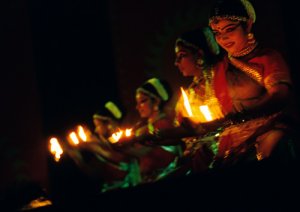 Diya dance
In the Kendra's 60 years celebrations, this year Ramlila in its latest avatar as Ram was staged from 16th till 25th October 2012 daily at 6.30pm in the open air premises of the Kendra, next to Kamani Auditorium to full houses, with surging crowds enjoying the eternal epic Ramayana on a specially erected stage. The entrance was specially created with paintings on either side by children who had submitted paintings of Ramayana story as a part of the drawing competition. When one entered the specially created gateway, one saw the paintings evoke an atmosphere and prepare one to witness the Ram katha. There is a Sanskrit saying: Yavat sthasyanti Girayah, saritascha mahitale, tavat Ramasya katha lokeshu pracharishyanti: So far there exist mountains on the earth and rivers flow, Ram's story will continue to be told and spread. I have happy memories of having watched earlier versions of Ramlila in the 60s and 70s.And watching Ram, those memories were enhanced. From the opening scene of the Kraunch birds frolicking and the hunter shooting one of them, seeing this Valmiki's utterances' Ma Nishad..' and turning of shoka (agony) into shloka (verse), the resultant story of Ramayana unfolds in quick succession. The power-point presentation in terms of story being projected on the screen in English helps those not familiar with sequences to relate to it. It also helps the foreigners who flock to see the Ramayana. Shoba has brought out an excellent booklet on Ramayana with reproduction of miniature paintings, the synopsis and director's note. It indeed is a collector's item as it has so many paintings and also narrative. 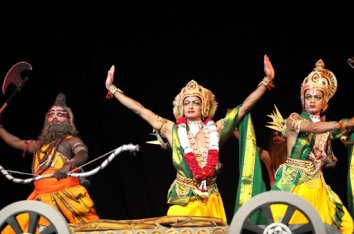 Parashurama, Rama & Lakshmana 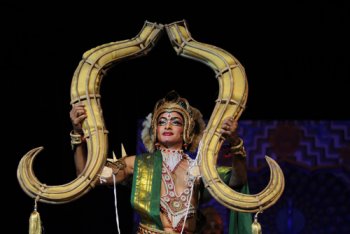 Rama breaks the bow 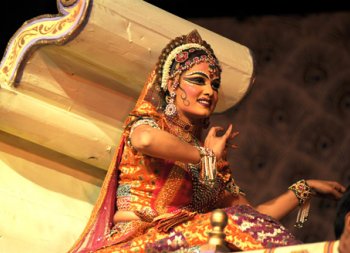 Sita enters swayamvaram 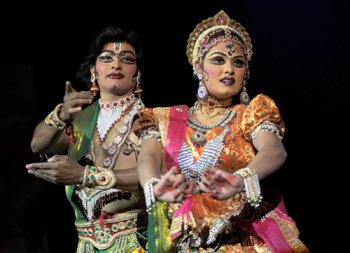 Rama & Sita in Pushpavanam At times, the characters descend from the stage and walk through the audience, and create a sense of participation. The quick changes of scenes with revolving screens, projection of video at the back were executed with split-second precision. Crossing of river, Kaivat taking Rama, Sita and Lakshmana in a boat had excellent choreography. Bharat milap was very touching and I had almost a catch in my throat! Scenes of Panchavati, Surpanakha's arrival, Lakshmana cutting her nose, her return to Lanka and crying before Ravana in his court were impressive scenes. Ravana in costume and make-up inspired from Kathakali, the courtiers with masks, had spectacular touches. The sequence of golden deer was well conceived with two dancers impersonating as deer and disappearing, creating an illusion. Sita Haran episode and Jatayu's fight, his informing Rama and Lakshmana about Sita's kidnapping by Ravana, Rama meeting Hanuman and Sugreeva, killing of Bali, Jatayu's elder brother Sampathi guiding Hanuman to Ashoka vatika (I did not know this incident), Hanuman's meeting with Sita, exchange of Rama's ring and Sita's Choodamani, Meghanad's catching Hanuman with magic lasso and Hanuman setting Lanka on fire are familiar episodes which leave a fine imprint on the mind. Rama and Lakshmana conduct yagna and the ocean surrenders, two ocean's agents surrender and arrange the stones to float, the bridge is built. The army of monkeys crosses the bridge. An interesting theatrical devise is used here by the director. The monkeys frolic and jump all over and sometimes they run among the audience and one or two monkeys sit on the sofa where audience is seated creating lot of commotion and humour. When Meghanad hurts Lakshmana, Hanuman flies and brings the hillock with medicinal herb which revives Lakshmana. The fight between Rama and Ravana takes place, Ravana is vanquished and Sita is rescued, but undergoes fire ordeal and finally after exile of fourteen years Rama, Lakshmana and Sita return to Ayodhya with Hanuman. And Pattabhishekam (coronation) takes place. 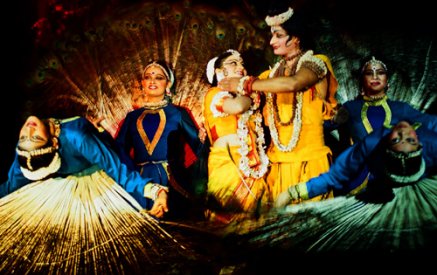 Panchavati 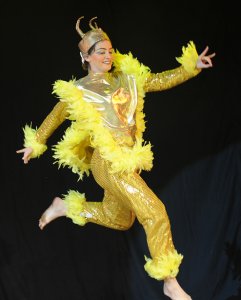 Golden deer 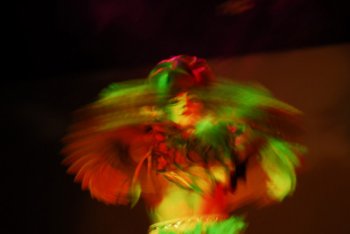 Jatayu 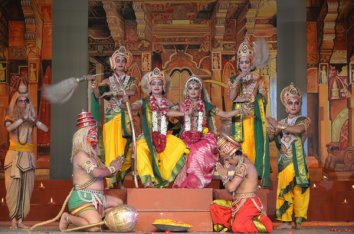 Pattabhishekam Those scenes are absolutely spectacular and colourful. The citizens dance with joy and there is shower of flowers and later on fireworks which illumine the stage with great spirit of festivity. The performance ends with haunting music, people hum the songs and leave the open air ground having enjoyed the performance. The entire cast performs with synchronization, and energetically, with quick changes of costumes and the production never loses its pace. It is the magic of an epic like Ramayana which through centuries has enthralled audiences and one never tires of seeing it. Delhi Govt's Art, Culture and Languages Department had sponsored the festival in Delhi Celebrates series and the admission was free. As Shobha Deepak Singh mentions in her Director's note: "When I turned to Valmiki's and Tulasidas's original texts, I was overwhelmed by their beauty and depth. Diving into the ocean of words contained in these texts one could present a vision of the Ramayana that everyone could embrace." Shriram Bharatiya Kala Kendra and Shobha Deepak Singh have placed the citizens of Delhi under a debt of gratitude by providing opportunities to re-visit Ramayana by such an engrossing fare. Credits are mentioned in the booklet as follows: Choreography by Shashidharan Nair, music by Shanti Sharma, Biswajit Roy Chowdhury, script by Arvind Kumar, costumes and ornaments by Shobha Deepak Singh, light design by Milind Srivastav, stage design by (late) Keshav Kothari, B.K. Sawant 'Badal'; graphic design /special effects, power-point presentation by Shobha Deepak Singh, technical assistance by Arvind Pandey, tailoring by Radhey Shyam, Neeraj, Sohan Lal. A large number of artistes have been involved in music and rendering of dialogues including Shanti Sharma, Jwala Prasad, Jitendra Singh, Indu Prakash, Anuradha Nirala, for dialogues (late) Manohar Singh, Abhinav Chaturvedi, Hema Sahai, Shanti Sharma and production advisor was (late) Keshav Kothari. A mind boggling team work carried out with great success. View Slide show  Dr. Sunil Kothari is a dance historian, scholar, author and a renowned dance critic. He is Vice President of World Dance Alliance Asia Pacific India chapter, based in New Delhi. He is honored by the President of India with Padma Shri, Sangeet Natak Akademi award and Senior Critic Award from Dance Critics Association, NYC. He is a regular contributor to www.narthaki.com, the roving critic for monthly magazine Sruti and is a contributing editor of Nartanam for the past 11 years. Post your comments Pl provide your name and email id along with your comment. All appropriate comments posted with name and email id in the blog will also be featured in the site. |